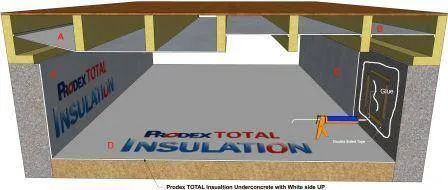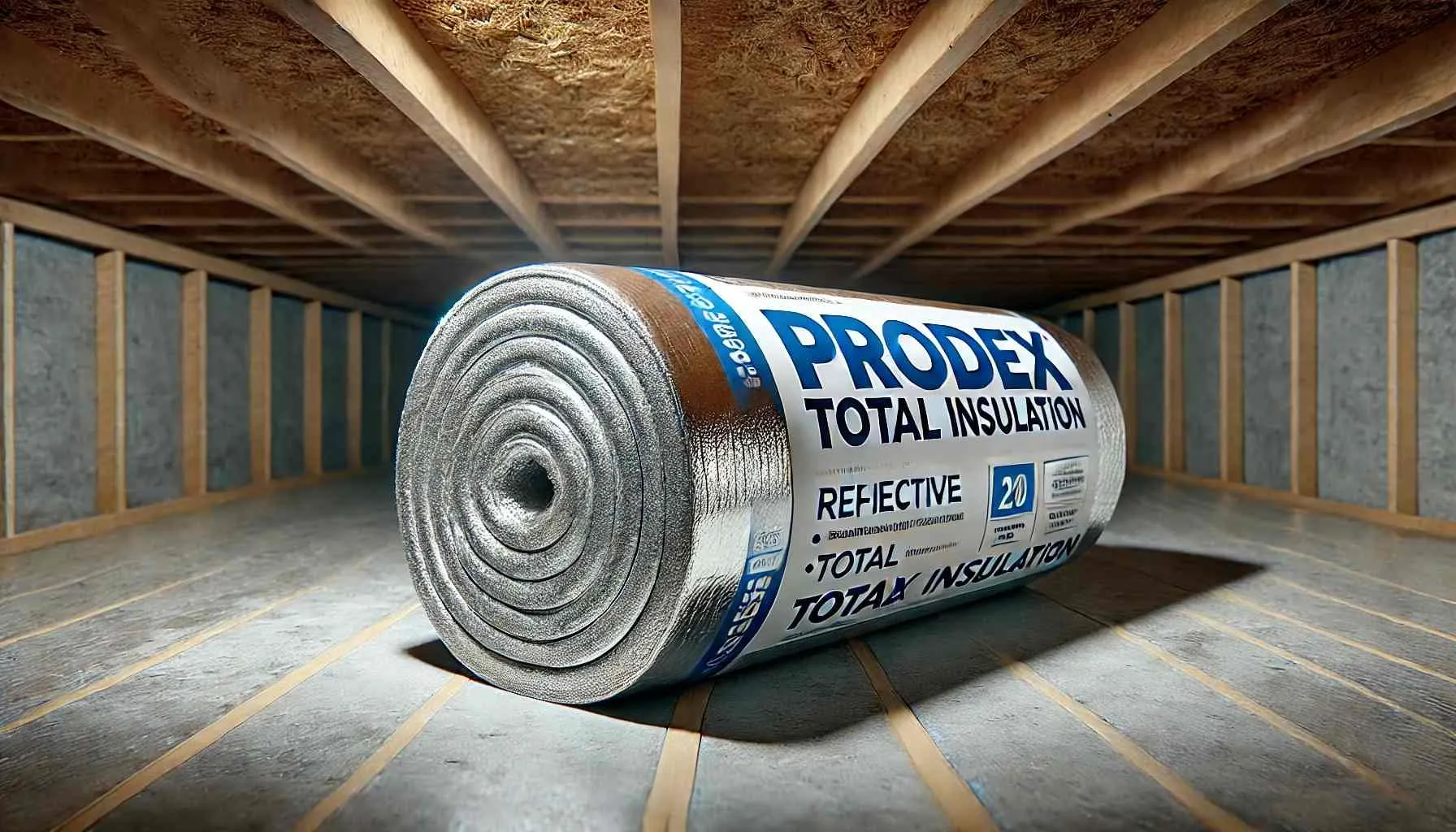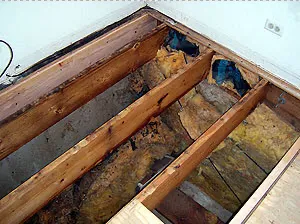INSTALL GUIDES: Crawl Space
Use: 10M, 48 Inch, 72 Inch, 24 Inch, 16 Inch, Under Concrete
Reflective tape, double sided tape, Super metal sealant
How to Insulate a Crawl Space
Insulating a Crawl Space Ceiling - Using Prodex Total Insulation

See diagram above
1. (option A) Staple or screw 10M, 48 INCH, 72 INCH or FAST ACTION under the floor joist. Tape seams with reflective tape. FAST ACTION and 10M don't require seam tape.
2. (option B) Depending on joist spacing, staple or screw 16 INCH or 24 INCH between joists one or more inches below floor board.
3. Combine method A and B to maximize performance.
Insulating Crawl Space Walls - Using Prodex Total Insulation
See diagram above
1. For optimal performance - stud or fur the wall.
2. Staple or screw Prodex Total between or under your studs or furring providing an inch or more air-gap.
3. (option C) Use Super Metal Sealant and double sided tape to attach the insulation directly to the wall.
Insulating Crawl Space Ground - Using Prodex Total Insulation
See diagram above
(D) Roll out Under Concrete Prodex Total (foil side facing up) on the ground. Tape seams with reflective tape.
How to Best Insulate a Crawl Space
When determining how to insulate a crawl space, follow these essential steps for long-term effectiveness:
1. Control Moisture First: Before installing crawl space insulation, check for any water issues. A vapor barrier is essential to prevent moisture buildup.
2. Choose the Right Insulation:
- Best Option: Prodex Total – Unlike fiberglass or rigid foam board, Prodex Total provides a combination of ease of installation, vapor resistance, and high R-value that's not affected by moisture, making it the top choice for both ventilated and unventilated crawl spaces.
- Alternative Insulation Types:
- Rigid Foam Board: Suitable for insulating crawl space walls, but installation difficulties in irregular spaces and the need for precise sealing can be a challenge.
- Fiberglass Batts: Works for insulating crawl space ceilings, but absorbs moisture, reducing effectiveness over time.
4. Install Prodex Total (overview):
- For Crawl Space Ceilings: Secure Prodex Total between or under floor joists to block heat transfer, moisture, and enhance comfort.
- For Crawl Space Walls: Attach Prodex Total directly to the walls with for a moisture barrier. Stud the wall and then attach Prodex Total to the stud for complete thermal protection and moisture barrier.
- For Crawl Space Floor: Roll Prodex Total out over the floor to serve as moisture barrier.
Crawl Space Insulation: Everything You Need to Know
Insulating your crawl space is one of the most effective ways to improve your home's energy efficiency, prevent moisture-related issues, and enhance indoor air quality. Whether you're wondering how to insulate a crawl space, searching for the best crawl space insulation, or exploring different installation methods, this guide will walk you through everything you need to know. We’ll discuss the importance of crawl space insulation, compare different insulation types, and explain why Prodex Total Insulation is the superior choice. Additionally, we’ll cover essential installation steps, moisture control strategies, and how to insulate both crawl space ceilings and walls for maximum effectiveness. By the end, you'll have a complete understanding of how to protect your crawl space and ensure long-term durability and comfort in your home.
Why Crawl Space Insulation Matters
Proper crawl space insulation is essential for improving energy efficiency, preventing moisture buildup, and enhancing indoor air quality. Without installing crawl space insulation, homes can suffer from heat loss, increased utility costs, and potential mold issues. If you're wondering how to insulate a crawl space effectively or searching for the best crawl space insulation, selecting the right product is key.
Among all insulation options, Prodex Total stands out as the best crawl space insulation due to its superior thermal efficiency, moisture resistance, and ease of installation.
Crawl Space Insulation - Moisture and Cold Are Primary Considerations
- Problems Caused by Moisture
- Challenges To Insulating a Crawl Space
- Components of the Best Crawl space Insulation
- Crawl space Insulation Options
- Installing Crawl space Insulation
- Why Buy Here
- Crawl space Insulation For Sale
- Pricing and Buying Crawl space Insulation
Due to the underground environment, moisture and cold are the primary considerations in developing a crawl space insulation strategy. Excess moisture can cause mold, mildew, odors, decay, fungus growth and wood rot. Cold temperatures below will increase your energy costs and make it less comfortable to walk on your floor.
The underground environment of a crawl space presents unique challenges. The moisture content in soil below three feet deep is almost always higher than the moisture content of the air inside. This difference in vapor pressure causes moisture to be driven from the soil into the crawl space interior by diffusion through the wall. A significant amount of moisture from the soil below the slab will wick upward into the crawl space. Prodex Total, vapor barrier crawl space insulation, solves your moisture and thermal protection needs.
Challenges To Insulating A Crawlspace
- The Soil below your home
- Hydrostatic pressure against the foundation wall from rainfall, snow melt or irrigation creates exterior diffusion
- Air infiltration bringing moisture in.
- Groundwater leakage through the foundation
- Interior diffusion from humidity in warm indoor air
- Condensation formed due to temperature differences between ground and wall
Underground soil temperatures can be much colder than either the outside air or the indoor air. The warmer the air of the basement constantly expands. When this warm air reaches the cooler surface of a wall next to the ground, condensation will occur on the interior of the wall. Any insulation in your crawl space will be subject to potentially large amounts of moisture driven from both the exterior and the interior depending on the season.
Air infiltration can be a major source of moisture entering your crawlspace. A lot more water vapor can move through a very small opening where the vapor pressure is greater on the exterior than can move through the wall surface by diffusion. Air-transported moisture can quickly lead to mold, mildew and decay in interior wall assemblies. Properly insulating a crawl space requires addressing all these challenges.
Fiberglass insulation should not be used in a crawlspace! To maintain its thermal effectiveness, fiberglass insulation cannot be exposed to moisture. Moisture will degrade the insulation R-value of fiberglass batts and promote mold and mildew. Installing a vapor barrier over the interior of fiberglass insulation will not prevent the foundation walls from drying to the interior, migrating capillary rise and ground water leakage. Batts with no vapor barrier will not be effective either as interior humidity will still cause loss of insulation R-value. U. S. Department of Energy: The R-value of some insulations also depends on...moisture accumulation.
Your home can act like a vacuum drawing radon up through the crawlspace in two ways. First, the air pressure inside is usually lower than pressure in the soil around the foundation. Second, warm air will rise to leak out creating a small amount of suction that can pull radon gas up through the crawlspace.
A poorly insulated crawlspace can account for 15 percent or more of a building's total heat loss. Prodex is most effective against downward radiant heat transfer making it a builder's choice for crawlspaces as a radiant barrier. Heat radiating downward from your floor into the crawlspace will be reflected back inside, saving energy and maintaining constant room temperatures. The most recent advance in crawlspace insulation is Prodex Total as a vapor barrier, radon barrier and insulation combined in one product.
Why Prodex Total is the Best Crawl Space Insulation
When comparing insulation options, Prodex Total is the superior choice for crawl space insulation because:
Combines Insulation + Vapor Barrier + radon protection: Unlike fiberglass or foam board, Prodex Total offers both thermal insulation, moisture resistance and radon protection in a single solution.
Prevents Mold & Moisture Issues: With its advanced foil-faced barrier and closed-cell foam interior, it blocks condensation and reduces mold risk.
Easy to Install: Lightweight and flexible, making installing crawl space insulation a straightforward DIY-friendly project.
Best for All Climates: Whether you're in a humid or cold climate, Prodex Total provides year-round protection for how to insulate a crawl space effectively.
For more on this subject: Crawl Space Insulation for Home Energy Savings









